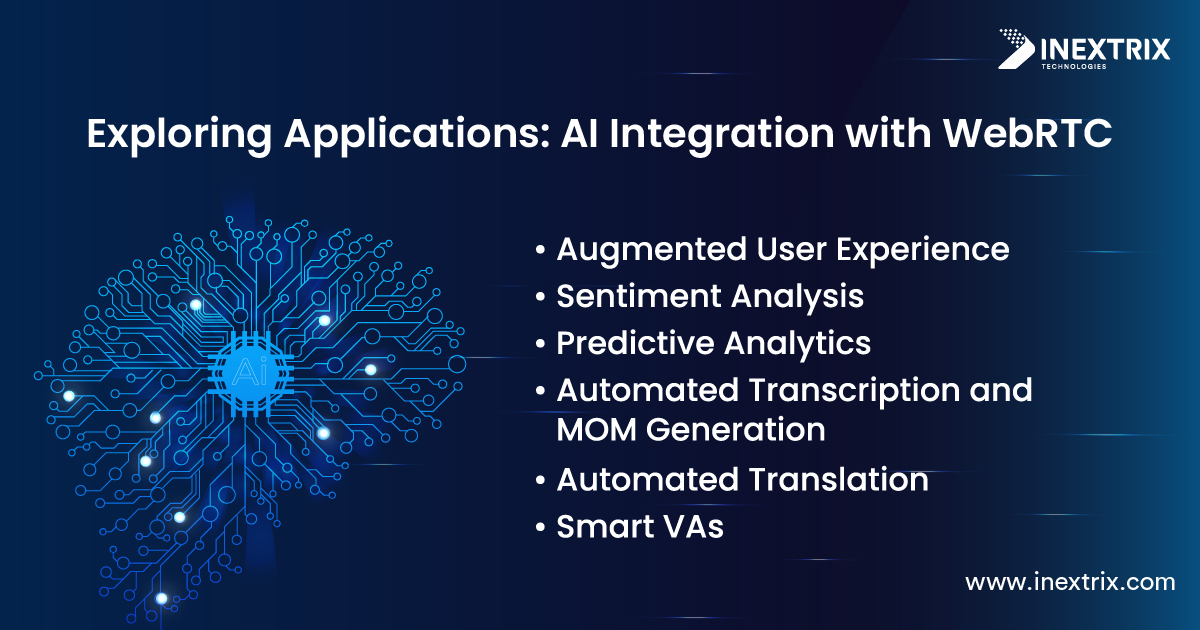Since its inception, WebRTC has been making headlines with its amazing features and support for seamless real time communication through web browsers. Likewise, AI (Artificial Intelligence) is also winning the hearts of end users and professionals due to its amazing advantages and brilliant innovations. Have you ever given it thought that if we combine the power of AI with WebRTC development solutions, then what would happen? Certainly, it can redefine the world of browser based real time communication.
AI has been paving its way into the VoIP development industry with automation, optimization, and several other driving elements. For example, AI has empowered routing strategies in the class 4 Softswitch to augment business models for wholesale VoIP service providers.
In this blog post, we will cover how AI is influencing WebRTC based communication tools. So, without any further delays, let’s get into the details of this interesting topic.
1. What is WebRTC?
WebRTC is an abbreviation for Web Real Time Communication. It is an open source framework that is developed to enable real time communication using browser technology. Certainly, it does not require any additional extensions, plug-ins, software, applications, etc. to conduct real time communication. Therefore, it is preferred by several professionals to conduct real time peer to peer communication.
WebRTC supports two way exchange of voice, video, and data. Therefore, WebRTC solution development helps in building different types of communication solutions that provide access to rich communication.
Undoubtedly, WebRTC is a highly secure communication technology because it uses robust security protocols like DTLS and SRTP to encrypt communication channels. Simply put, it encrypts voice and data packets that are exchanged online. Therefore, even if communication lines are intercepted, the real information will still be protected from theft and misuse.
Besides real time communication, WebRTC also supports cross-platform operations. Definitely, it does not have any technology restrictions. For example, one user can use MacOS, and another can use Windows for peer to peer connection. Furthermore, it can overcome NAT challenges, which provides a high level of compatibility even if users use different web browsers for communication.
In a nutshell, WebRTC is a perfect technology that can provide reliable and dependency free peer to peer communication tools. The right WebRTC app development company can build different types of communication applications such as video conferencing, voice calling, live streaming, and more.
2. How to Mingle WebRTC and AI?

As discussed earlier, WebRTC and AI are two powerful technologies that are useful in building different types of communication tools and applications. AI needs no introduction as it has become the talk of the town in the past decade. Definitely, you can combine AI and your innovation with any technology and can do wonders. Today, we will see how a thoughtful blend of AI and WebRTC can do wonders for your business or customers in detail.
You can combine the power of WebRTC with Artificial Intelligence to elevate real time communication applications and the value and standards of these tools. This union enables developers to craft smarter and more engaging user experiences for the user of WebRTC tools for peer to peer calls and conferences.
An effective approach to combining WebRTC and AI involves integrating AI-driven features directly into communication platforms developed using WebRTC development services. This combination of WebRTC and AI empowers developers to bring in groundbreaking elements. Moreover, they can improve communication, automate specific processes, and deliver more personalized and efficient user interactions. Eventually, the mixing of WebRTC and AI enriches the capabilities of communication applications, paving the way for advanced features and heightened user satisfaction.
To be more specific, here are the top three ways you can mingle WebRTC and AI.
Integrating AI Into WebRTC Applications
There are already some WebRTC based solutions developed such as web conferencing solutions, WebRTC client solutions, web phones, and more. As we already know, there are several features and algorithms developed in AI that an experienced developer can easily integrate into the WebRTC applications. For example, AI-powered speech recognition, Natural Language Processing (NLP), sentiment analysis, facial recognition, and several other AI driven tools are available to integrate into WebRTC applications. These tools can help you improve user experience and benefits of using WebRTC tools and solutions.
Adding WebRTC Based Communication Into AI Tools
Likewise, there are several AI based tools available in the market. You can integrate WebRTC based communication features into these AI applications to add real time communication functionality into AI based tools.
Read Also: AI Augmenting the World of VoIP Application Development
For example, in an RPA app that is developed using AI technology, you can implement real time calling features to let team members communicate using WebRTC technology.
Identify Innovative Ways for Mingling AI and WebRTC
Traditionally, you can either integrate AI functionality into a WebRTC application or WebRTC based communication features into an AI solution. However, this is not the end. Certainly, there are endless possibilities when it comes to building powerful communication tools with the right mingle of AI and WebRTC. You can use your creativity and vision to identify untapped opportunities and build powerful applications that provide competitive and future-proof functionalities.
3. Use case of AI and WebRTC

Certainly, there are endless possibilities to build diverse powerful apps using Artificial Intelligence and WebRTC development solutions. Let’s check some of the amazing use cases of the influential role of AI and WebRTC that will dominate the telecommunication industry in the upcoming years.
Augmented User Experience
Several WebRTC applications manage hundreds of peer to peer calls and conferences. Moreover, WebRTC apps also support data, multimedia, and instant message exchange. In short, there are different communication channels integrated into WebRTC tools that are in use in corporate and several other industry verticals.
Developers can implement AI algorithms into these WebRTC tools to process historical data stored during a WebRTC session. The AI algorithms will analyze user behavior, preferences, and habits by processing the session data. Moreover, AI algorithms will identify certain patterns to come up with personalized recommendations, suggestions, or responses. As a result, managers or other concerned professionals can use this information for personalized calls and conferences. Moreover, this practice will directly enhance the overall user experience and engagement.
Sentiment Analysis
Undoubtedly, we cannot miss talking about sentiment analysis while discussing AI for communication. Fundamentally, WebRTC tools are used to conduct different business meetings. For example, a product demo to a new client or an onboarding process to an investor is discussed through a WebRTC communication solution. Unquestionably, WebRTC makes this communication engaging by integrating video, screen sharing, and several other rich communication features into this business calling solution.
In addition to rich communication, AI algorithms for sentiment analysis are available to integrate into these WebRTC solutions. Definitely, a WebRTC app development company can integrate voice and/or video sentiment analysis algorithms to analyze voice tone, facial expressions, and spoken words during a conversation. As a result, the overall sentiments of participants are available to process. Definitely, this information is highly valuable for businesses to make future strategies. For example, this information can display how happy or unhappy customers are. Moreover, it can indicate the interest level of an investor, or which point caused doubts in the mind of an investor to make the right pitch for the next call.
Predictive Analytics
Similar to sentiment analysis, predictive analytics is a must discuss feature of AI for WebRTC. Predictive analytics can process past data to predict several elements of the upcoming meetings. Basically, it can predict the best time to schedule a meeting from 8 AM to 10 AM on Thursday. Likewise, it can predict possible network congestion during the next meeting to make the required adjustments. Likewise, predictive analytics can make several predictions that a business can use for better planning and smooth communication.
Elevate your online collaboration capabilities with our cutting-edge WebRTC development solution.
Firstly, it can help in improving user experience. Secondly, it can aid in making communication seamless and straightforward. Thirdly, it can help in being prepared for any type of meeting to increase the success rate.
Automated Transcription and MOM Generation
AI-powered speech-to-text algorithms are available to integrate with WebRTC tools during the WebRTC solution development process. This AI algorithm will automate the process of transcribing spoken words into text in real time. Moreover, with the right development expertise, this transcription is displayed as captions during a live call or conference. This helps in improving customer understanding if there are multiple non-native speakers or people with pace issues.
In addition to generating and displaying transcription, developers can program AI algorithms to extract highlights or summaries of the call conducted through a WebRTC conferencing tool. AI can create a bullet point or graphical representation of the summary of the call. Moreover, it can email the Minutes of the Meeting (MOM) to all participants who participated in that conference or everyone who is invited to participate in the meeting.
Automated Translation
We live in an era of digitization and globalization. Certainly, businesses are growing in leaps and bounds and creating a global identity. Therefore, businesses need to deal with a variety of people who speak different languages. Definitely, there is always an option to hire a native translator who can help you with translation services. However, this process is quite expensive, slow, and intricate in several cases. Thanks to the mingle of AI and WebRTC, this issue is resolved seamlessly.
AI-powered language translation algorithms are available to integrate with WebRTC applications. These algorithms automatically translate conversations in real time. Additionally, you can use AI-powered language transcript algorithms to display translated conversion in your native language. In short, a complete multilingual WebRTC tool can be developed with the help of the right development technique that makes conversation simplified even when non-native speakers are part of the call.
Smart VAs
Virtual Assistants (VAs) like Siri, Alexa, and Hello Google are making our lives easier. Certainly, you all must have used these VAs in your routine lives. The same can be implemented with WebRTC solutions. Typically, the right WebRTC solutions that can deliver excellent value with the implementation of smart virtual assistants are related to customer care or automated inquiries.
For example, if you are using a WebRTC based chat widget or voice assistant on your website. You can use an AI algorithm to develop and integrate virtual assistants within that WebRTC application. This AI-powered WebRTC solution will allow users to interact with intelligent bots to take common actions. For example, users can schedule an appointment with a dentist. Secondly, a customer can check the past payment details or upcoming bill’s due date.
Additionally, voice assistants are also available to provide more engaging assistance during an interaction with the WebRTC tool. Certainly, this will remove human agents to automate some level of user interactions.
4. Future Trends of AI and WebRTC Based Solutions
Definitely, AI and WebRTC amalgamation is a hot topic in the industry. As a result, several innovations are taking place in this industry. Therefore, there will be several buzzing trends increasing the curiosity of everyone related to the telecommunication industry.
Some of the major future trends include:
- Edge Computing: The rise of edge computing will enable decentralized AI processing for real time decision making. This will empower WebRTC based communication tools to help participants to make faster decisions.
- Highly Personalized Experience: AI and WebRTC collaboration will offer tailored communication experiences based on user preferences with more detailed and user specific personalization.
- Quality Optimization: AI will optimize WebRTC sessions in real time by reducing latency, network congestion, and similar issues. As a result, the quality of audio and video will become better. Moreover, WebRTC tools will deliver a seamless user experience.
- Integration with Other Trending Technologies: Certainly, we can expect integration of AI and WebRTC based solutions with IoT, AR, VR, and other technologies for immersive communication experiences.
- Improved Security: AI will reinforce security in WebRTC based applications. Therefore, WebRTC apps can ensure even better encryption and proactive threat detection to provide a secure communication experience.
Concluding Note
In summary, we can say that, mingle of AI and WebRTC is going to amaze all industry verticals. Moreover, it will increase the adoption of WebRTC based communication tools by adding more engaging, robust, and reliable features.
We help our worldwide customers with our expertise in AI and WebRTC development services. Undoubtedly, we can help you with our proficiency in both of these technologies to build future-proof and competitive solutions. To learn more about our services and WebRTC development solutions, contact us now.


